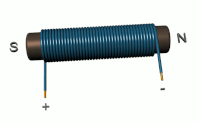
Photo from wikipedia
45 T is the highest continuous magnetic field available to the scientific user community, and this now since practically 20 years. We address the question of how to access the next… Click to show full abstract
45 T is the highest continuous magnetic field available to the scientific user community, and this now since practically 20 years. We address the question of how to access the next level, defined as 60 T, with a hybrid magnet. The outsert, wound from low-temperature superconductors (LTS) will generate the highest field possible: 18–20 T in a 1 m bore. For the inner part, two approaches are investigated: a high-power resistive magnet or a combination of a resistive insert magnet and a “midsert” magnet employing high temperature superconductors (HTS). First rough estimates suggest equal field contributions of 20 T from the LTS outsert, HTS midsert and the resistive insert. We have then investigated of how to optimize dimensions and field contributions from the three subsystems under the primary constraint of actual feasibility and investment cost. Additional constraints are: a) current density and stress levels of the outsert conductor including its reinforcement, b) conductor and coil winding options and their maturity confidence for the midsert and c) stress level, power density, and available power for the insert. For insert and outsert a large basis of experience exists, from which reasonable extrapolations can be made with sufficient certainty. This is not the case for the HTS coil, where important decisions have to be justified, such as conductor type and its reinforcement, nature of insulation and winding techniques. Conductor cost reduces in our optimization routine the HTS contribution to a minimum; however, progress in HTS magnet technology and projected cost reductions are impressive; they are included in our estimations. The results of our detailed magnet design and optimization calculations indicate that it is feasible to build a 60 T hybrid magnet of rather compact dimensions with a maximum total magnet height of 1.3 m and an outer diameter of only 1.8 m. Distinct, feasible developments of the HTS and LTS conductors and resistive magnet technology have been defined. We propose a novel method, the fast ramp-down of the resistive insert, to safely protect the HTS midsert by quenching it globally and instantaneously.
Journal Title: IEEE Transactions on Applied Superconductivity
Year Published: 2020
Link to full text (if available)
Share on Social Media: Sign Up to like & get
recommendations!